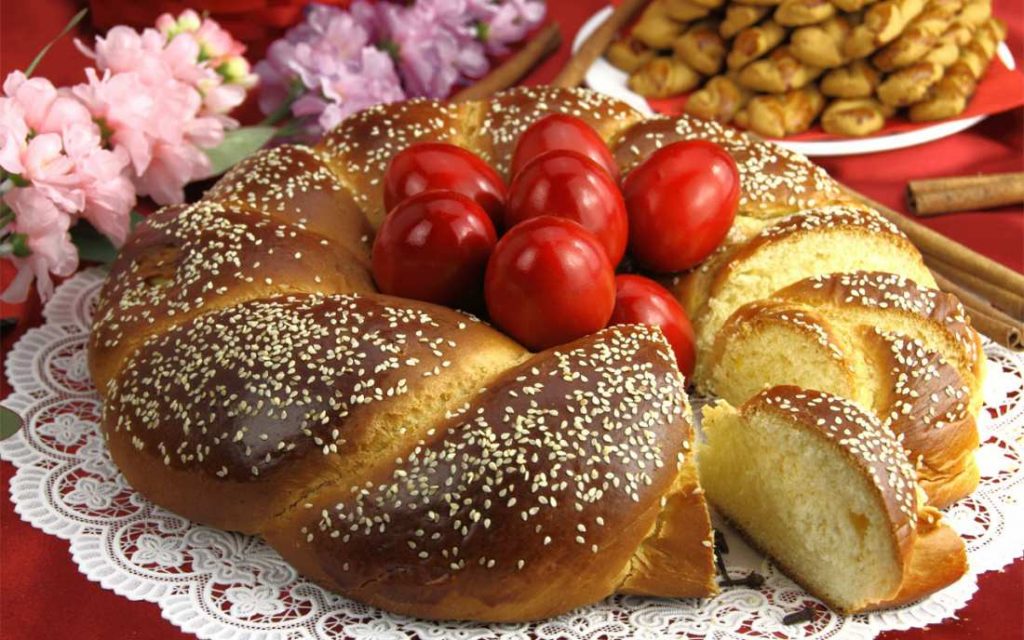Tsoureki: A Beloved Greek Easter Bread and Its Timeless Traditional Recipe

Tsoureki (τσουρέκι in Greek) is the traditional sweet yeast bread Greeks make every year on Holy Thursday, which is then consumed on Easter Sunday.
Early in the morning on Holy Thursday, throughout Greece, women start kneading the dough for the tsoureki.
Some bakers decorate the loaves with nuts and sugar. Depending on the shape and the region of Greece, tsoureki has different names, such as “kofinia,” “kalathakia,” “doksaria,” “avgoulas,” “koutsouna,” and “kouzounakia” among others. The most common shape for the ubiquitous bread is the braid.
The braids and knots, however, have their origin in pagan times when certain shapes of bread were purported to chase away evil spirits.
Tradition has it that the tsoureki symbolizes the Resurrection of Christ and rebirth in general, as the flour is molded into shape and rises and takes on life while transforming into its final shape.
The red-dyed egg, which is usually placed on top of the braid, symbolizes the blood of Jesus. Dying eggs red in anticipation of Greek Easter is one of the oldest and most beloved traditions in Greece.
Breads similar to the tsoureki were made in Byzantine times
Breads similar to the tsoureki are known to have been made in Byzantine times. Called “kollyrides,” they were considered the special breads of Easter. They also had different shapes and had a red egg in the middle.
The name tsoureki comes from the Turkish word “corek” which refers to any bread made with yeast dough. There are many kinds of corek, both savory and sweet, which appear in various shapes and sizes depending on the region. The Turkish variant features egg incorporated into the dough, rather than unbroken eggs pressed into the dough by way of decoration.
The word for the bread was adopted by Greeks during the Turkish occupation, and ever since then, Greeks began making their own version of the sweet bread, made with milk, butter, and eggs.
Armenians and people in Azerbaijan make a type of corek which is a round flatbread sprinkled with sesame seeds.
Today, tsoureki has become an all-year-round pastry. Various versions, such as filled or covered with chocolate and nuts can be found, and it can even be filled with custard or dipped in syrup.
Sometimes tsoureki is used as a gift for a special occasion, for instance, it can be given as an Easter gift from children to their godparents.
Even eaten plain, this delicately sweet bread is delightful and hits the spot after the long privations of the Lenten period.
Recipe for tsoureki
In a mixer, beat 6 eggs with 110z/310gr sugar.
-Mix for 8 minutes
Add: 2 tsp of Mahlepi and ½ tsp trimmed Mastiha
-Mix for 3 minutes
Add: 1 Lb of flour
-Mix for 3 minutes
Add 8 fl oz/235ml of hot milk, 3 fl oz/90ml of melted butter
-Mix for 2 minutes
Add 1 Lb of flour and 0.5oz/15gr of dry yeast
– Mix for 10 minutes
– Let the dough rise for 1 hour
-Shape into three thick ropes and then braid together
-Let rise for 45 minutes.
-Place some egg yolk thinned with water on top and decorate with slivered almonds
-Bake in a preheated oven at 320°F/160°C for 30 to 40 minutes
Enjoy!
Business Wire






No comments